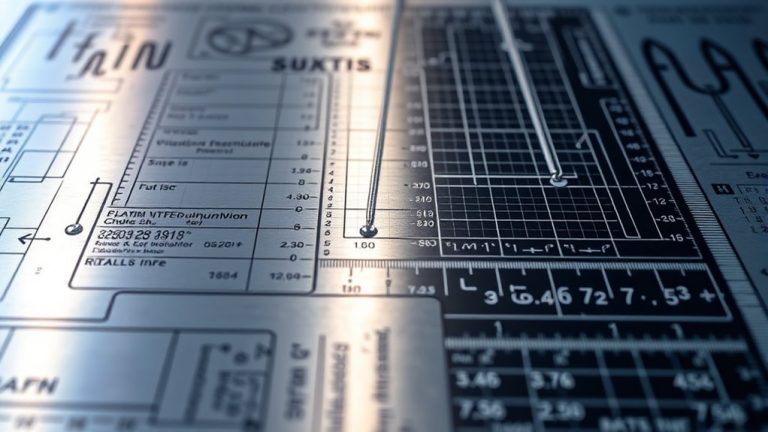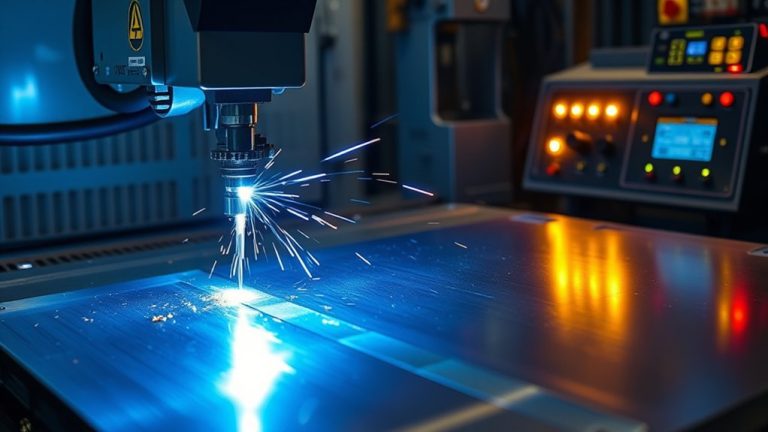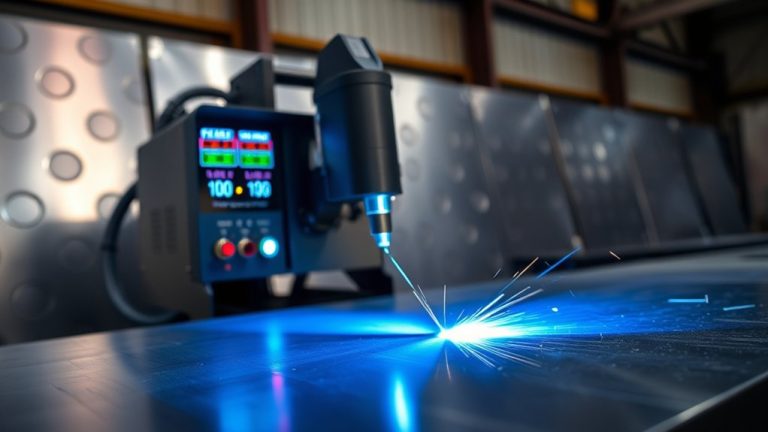Imagine you’re tasked with cutting 1/8 inch aluminum for a project, and you need precise settings on your plasma cutter. You’ll want to set the machine to 45 amps and aim for a cutting speed around 70-75 inches per minute. Nitrogen gas is your best bet for both plasma and shield to reduce oxidation. Keep the torch height consistently between 1/16 to 1/8 inch above the material. But what about ensuring a clean cut?
Essential Settings for Cutting Aluminum With a Plasma Cutter

When you’re setting up a plasma cutter for aluminum, it’s essential to get the settings right to guarantee clean and precise cuts.
Begin by selecting the appropriate amperage; for 1/8 inch aluminum, 45 amps is ideal. This setting, combined with a cutting speed of 70-75 inches per minute, provides optimal results.
Utilize nitrogen gas for aluminum thicknesses under 5 mm to achieve clean cuts and minimize oxidation.
Maintain a consistent torch height as outlined in the manual to reduce dross and enhance cut quality.
It’s important to adjust air pressure correctly; improper settings can lead to the torch “cutting out,” affecting performance.
Continuous monitoring of torch speed and height control is necessary for maintaining precision.
Always refer to the manufacturer’s cut charts for specific settings based on aluminum thickness to fine-tune your plasma cutting aluminum process.
This approach maximizes efficiency and guarantees excellent results.
Selecting the Right Gas for Optimal Aluminum Cutting

Achieving precise aluminum cuts with a plasma cutter hinges on not just the settings but also on selecting the right gas. For aluminum cutting under 5 mm, employing nitrogen as both the plasma gas and shield gas guarantees ideal cut quality and limits oxidation. This choice is vital for maintaining a clean cut, minimizing dross, and enhancing edge quality.
For aluminum under 5 mm, use nitrogen as both plasma and shield gas for optimal cut quality.
When dealing with aluminum thicker than 6 mm, it’s advisable to use nitrogen as the plasma gas paired with water as the shield gas, which greatly improves edge quality and reduces dross formation.
Avoid using air plasma, as it can lead to oxidation and poor surface quality. Instead, opt for nitrogen or argon-hydrogen mixtures, especially with thicker materials. The gas mixture directly affects the cutting process, enhancing cut quality and prolonging consumable life.
Following manufacturer recommendations is important to prevent poor surface quality and excessive slag, guaranteeing cleaner, more efficient aluminum cutting.
Techniques for Achieving Clean Cuts on Aluminum

To achieve clean cuts on aluminum, it is vital to maintain a precise torch height, typically between 1/16 to 1/8 inch above the workpiece, as specified in the manual. This guarantees ideal arc stability and enhances cut quality during the plasma cutting process. When cutting aluminum under 5 mm, using nitrogen as both plasma and shield gas minimizes oxidation, producing a cleaner edge.
Adjust the cutting speed to approximately 70-75 inches per minute for 1/8 inch aluminum. This speed, paired with the correct amperage of around 45 amps, facilitates tight tolerances and prevents arc instability. A solid ground connection is fundamental to achieving a consistent and clean edge.
| Parameter | Recommended Setting | Purpose |
|---|---|---|
| Torch Height | 1/16 to 1/8 inch | Arc stability, cut quality |
| Gas Type | Nitrogen | Minimize oxidation |
| Cutting Speed | 70-75 inches per minute | Prevent dross formation |
Adjust these parameters based on the thickness of the aluminum for ideal results.
Understanding the Impact of Material Thickness on Plasma Cutting

Building on the techniques for achieving clean cuts on aluminum, understanding how material thickness influences plasma cutting parameters is critical for ideal results. When dealing with aluminum, the material thickness dictates the necessary amperage; thicker pieces, over 1/4 inch, often require more than 45 amps.
For optimal cut quality, especially in sheets under 5 mm, using nitrogen as both plasma and shield gas is advantageous. Thicker materials benefit from combining nitrogen plasma with a water shield gas.
Consistent torch height is essential to manage cut quality and minimize distortion across varying thicknesses. Adjusting cutting speeds and feed rates is equally important; slower speeds prevent excessive dross on thicker aluminum, guaranteeing a smooth edge finish.
Additionally, account for kerf width, as it changes with material thickness. This requires kerf compensation in design to avoid material waste and maintain part accuracy. Understanding these factors guarantees precise and efficient aluminum cuts.
Safety Measures and Considerations for Plasma Cutting Aluminum

When plasma cutting aluminum, safety is paramount due to the unique risks associated with the process. Implementing effective safety measures is essential.
First, always wear personal protective equipment (PPE) like gloves, goggles, and flame-resistant clothing to shield yourself from sparks and harmful UV radiation. Guarantee proper ventilation in your workspace to avert hazardous fumes, which can be particularly toxic when cutting aluminum.
Maintain a safe distance from flammable materials, as the high temperatures can easily ignite them. Be mindful of hydrogen gas accumulation, especially when using water tables, to reduce explosion risks—consider using aerators as a precaution.
Regular equipment maintenance is non-negotiable. Inspect your plasma cutter routinely to prevent malfunctions that could lead to accidents. Pay special attention to the ground clamp connection for effective grounding.
Frequently Asked Questions
What Are the Settings for Plasma Cutting Aluminum?
You need to adjust amperage settings based on aluminum thickness, optimize cutting speed for arc stability, and select the correct nozzle diameter. Guarantee proper material preparation, manage heat, set an appropriate cutting angle, and maintain pilot arc and consumable longevity.
Can You Cut Aluminum on a Plasma Cutter?
Yes, you can cut aluminum on a plasma cutter. Consider aluminum thickness, choose compatible electrode types and nozzle sizes, adjust cutting speed, follow safety precautions, select suitable plasma cutter brands, and guarantee proper cooling methods and maintenance.
What Should a Plasma Cutter Be Set At?
Ironically, your plasma cutter settings aren’t a guessing game. For ideal results, adjust amperage settings, cutting speed, and air pressure based on material thickness. Guarantee nozzle diameter, voltage adjustment, arc stability, torch angle, and workpiece preparation are precise.
What Gas for Plasma Cutting Aluminum?
For plasma cutting aluminum, use argon gas mixtures for ideal plasma efficiency and arc stability. Avoid oxygen cutting due to poor surface quality. Consider aluminum thickness, cutting speed, nozzle type, heat input, and shielding gas for effective surface preparation.
Conclusion
When using a plasma cutter on 1/8 inch aluminum, remember that precision in settings can make all the difference. With the right setup—45 amps, a cutting speed of 70-75 inches per minute, and a torch height between 1/16 to 1/8 inch—you’ll get clean, oxidation-free cuts. Curiously, optimizing these parameters can increase productivity by up to 30%. Don’t forget to verify a solid ground connection and use nitrogen gas for both plasma and shield to achieve the best results.



